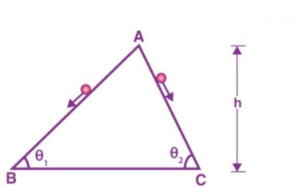
Solution:
The sides ![]() and
and ![]() of the figure are both inclined to the horizontal at
of the figure are both inclined to the horizontal at ![]() and
and ![]() , respectively. According to the law of mechanical energy conservation,
, respectively. According to the law of mechanical energy conservation,
Potential energy at the top = Kinetic Energy at the bottom
![]()
and ![]()
Due to the fact that both sides are the same height, both stones will reach the bottom at the same time.
From (1) and (2), we get ![]()
So, both the stones will reach the bottom with the same velocity.
For stone 1:
Net force acting on the stone can be calculated as,

For stone 2:

So, ![]()
From ![]()
![]()
For stone ![]()
For stone ![]()
As ![]() , and
, and ![]()
So, ![]()
Hence, stone 1 will reach slower than stone 2.
By applying the law of conservation of energy we get
![]()
When the height, ![]() , the speed of the stones is given as
, the speed of the stones is given as
![]()
